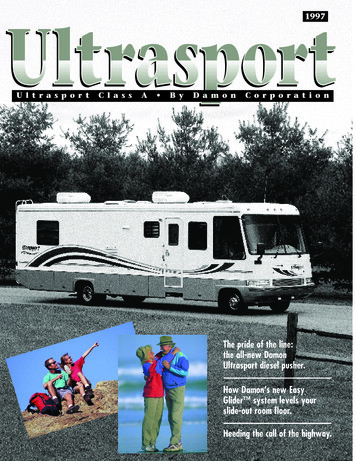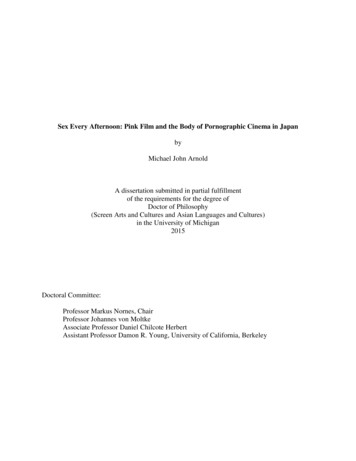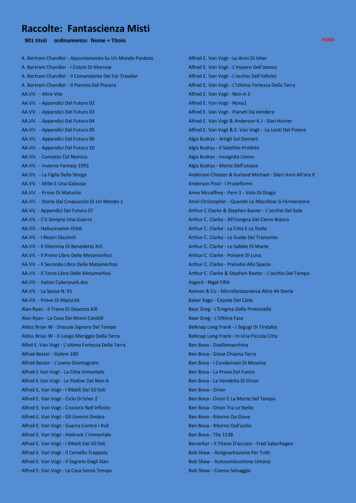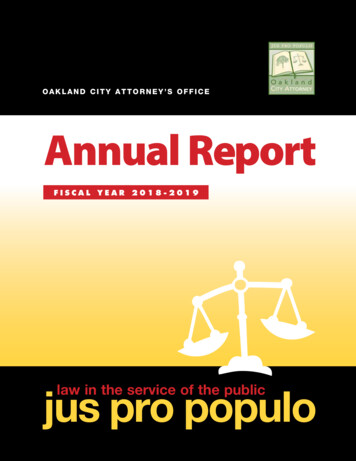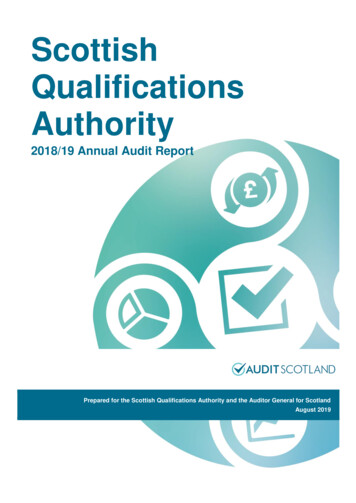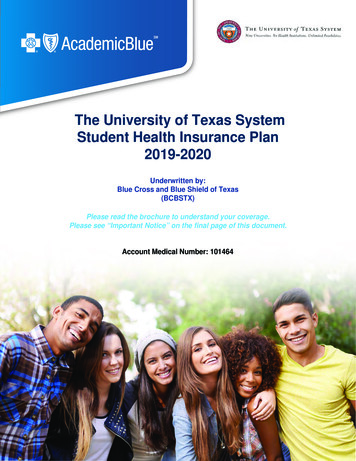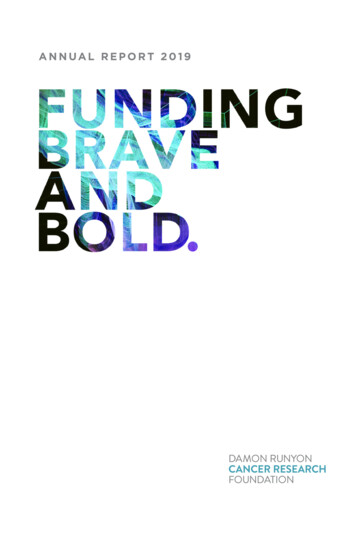
Transcription
ANNUAL REPORT 2019
Funding brave and bold.Cancer. No disease inthe history of medicinehas proven more elusive andresilient. It defies logic. It’sunpredictable. It hides in plainsight. It evolves. And it’s soonto be the number one killer inAmerica.OURThe very nature of cancer is why,at the Damon Runyon CancerResearch Foundation,we believe that only by pursuingand investing in the mostaudacious and ambitious ideaswill we achieve victory overhumankind’s deadliest enemy.Our research focus is singular:high-risk, high-reward.Research that others mightdeem radical or believe to bereaching too far. Research thathas a good chance of failure, butat the same time has a chance tofundamentally change the game.Who does that kind ofresearch?Young scientists with thebrilliance and unbridled passionto push boundaries and breakrules. People with the incrediblebrainpower to earn millionsof dollars on Wall Street or inSilicon Valley, but who havechosen to take a different path,a path that could instead savemillions of lives.2And we support them thebest way we know how— withthe money they need to bringtheir ideas from whiteboardsto reality. The funding andfreedom to pursue theories,concepts and strategies thatothers are not brave or boldenough to bet their careers on.Brave and bold.That’s where the DamonRunyon Cancer ResearchFoundation invests. That’swhere we believe the answerswill come from.Brave and bold.The only two words that willbeat cancer.3
A MESSAG E F R O M T H EP RES I DE NT & C E OMost recently, we identified a critical area forcancer research: quantitative biology. In thiscurrent era of vast amounts of patient data(genetic and clinical) and research data, thereis an urgent need for scientists with the unique“WE LOOK FOR THENEXT FRONTIERS,AREAS THAT AREMOST PROMISING ANDYUNG S. LIE, PhDSHOW THE GREATESTDAMON RUNYON’S NOBELPRIZE-WINNING SCIENTIFICBREAKTHROUGHSQuantitative Biology Fellowship Award, torecruit and invest in these people.Earlier this year, we increased our Innovationand Clinical Investigator Awards by 33%to provide more robust and much-neededadditional resources to our scientists. Thisnew quantitative biology program (describedmore on page 6) will further increase ourannual Damon Runyon award programsbudget to nearly 21.5 million in 2020. Weare confident that our sustained investmentwill lead to even more brave and bold impacton cancer research.Discovery ofmachineryregulating vesicletraffic, a majortransport systemin our cellsDiscoveryof catalyticpropertiesof RNADiscovery ofthe geneticprinciple forgenerationof antibodydiversityDiscoveriesconcerningthe structuraland functionalorganizationof the cellPOTENTIAL FOROur scientists are brave and bold. They havetaken the path less traveled, a path that couldsave lives and change medicine forever.As an organization, we also strive to be braveand bold. We look for the next frontiers,areas that are most promising and show thegreatest potential for breakthroughs. Weseek opportunities to provide funding thatis catalytic to young innovative scientists, tocancer research and to cancer patients. Ouresteemed scientific leaders work with us torigorously evaluate the research landscape,identifying areas where breakthroughs areneeded and looking for gaps in funding. Wework efficiently and rapidly to design andcreate mechanisms to respond to these needsand fill these gaps. We ask our current DamonRunyon scientists to help us brainstorm otherways we can support their career trajectoryand success, and accelerate their progress.4BREAKTHROUGHS.”expertise to analyze these data in the best waypossible. What can we learn from these data—when combined, compared, sorted in theright ways or perhaps unexpected ways—thatwill inform how to improve cancer treatment,diagnosis, and prevention? What are the righttypes of data to collect in order to exploreimportant questions in cancer?Can we learn more about how cancersevolve and develop resistance to therapy,or transition from latent to acute disease?To answer these questions, we needscientists who are specially trained to workin quantitative fields (such as mathematics,physics, computer science) in addition tocancer biology. For these reasons, we areproud and excited to announce that we havecreated a new program, the Damon RunyonDAMON RUNYONBOARD MEMBERDiscoveries concerningthe replicationmechanism andthe geneticstructure of virusesDiscoveriesconcerninghormonaltreatment ofprostatic cancerWILLIAM G. KAELIN,JR., MD, WINS 2019NOBEL PRIZEWilliam G. Kaelin, Jr., MD,shares the Nobel Prize inPhysiology or Medicinefor discoveries of how cellssense and adapt to oxygenavailability. This work has ledto the development of potentialdrugs for heart attack, stroke, anemiaand cancer. Dr. Kaelin has shownincredible dedication to the leadershipof the Foundation’s scientific programs,particularly the Clinical Investigator andPhysician-Scientist Training Awards.Discovery thatgenes act byregulatingdefinite chemicaleventsDiscovery ofthe ability ofpoliomyelitisviruses to grow incultures of varioustypes of tissueDiscovery ofco-enzyme A andits importancefor intermediarymetabolismPreparation ofenzymes and virusproteins in a pure formDiscovery of the chemicalnature of vitamin KDiscoveriesin connectionwith thebiologicalcombustionprocesses5
Q U A N T I TAT I V EAINAUGURAWARDLB I O L O G YWe are at a unique time in cancerresearch, when the volume anddiversity of data—includinggenome sequences, catalogs of all theproteins in a single cell and patientinformation such as pathology and imaging—is exponentially growing. Increasingly,biologists are required to not only work atthe lab bench, but also mine vast amountsof data to find the valuable clues that willaddress key challenges in cancer researchand patient treatment.Damon Runyon anticipates the need foran elite cadre of computational biologyleaders with expertise and understandingin both quantitative and biologicalsciences—scientists who are capable oftraversing both worlds with ease and“BECAUSE THIS ISMEET AVIV REGEV, PhDIN ESSENCE A NEWThe Foundation is thrilled to haveone of the world’s most accomplishedcomputational biologists, Aviv Regev,PhD, lead the selection committee forthe new Damon Runyon QuantitativeBiology Fellowship Award. “Shehas a proven track record of usingquantitative tools to drive majordiscoveries in cancer,” says Todd R.Golub, MD, of the Broad Institute,and Damon Runyon Board Member.Dr. Regev, also of the Broad Institute,has pioneered many leadingexperimental and computationalmethods that are now widely usedby her colleagues in the field. She isco-leading one of the most ambitiousprojects in the history of biology—theHuman Cell Atlas—which is creatinga reference map that categorizes theapproximately 37 trillion cells thatcomprise the human body.FIELD.IT IS CRITICALTO DRAW FEARLESS2020AND BRILLIANTYOUNG SCIENTISTSTO THESE PROBLEMSTO DRIVE THE FIELDFORWARD.”F E L LOWS H I P6AVIV REGEV, PhDare truly bilingual, comfortably speakingboth languages fluently. Highly skilledquantitative scientists, however, may be7
Q U A N T I T A T I V EB I O L O G YF E L L O W S H I PA W A R DQ&A WITH DR. AVIV REGEVpulled toward the technology industryto create the next Google, Amazon orYouTube. To proactively address thisneed, Damon Runyon has created a newfunding mechanism designed to encouragequantitative scientists (trained in fields suchas mathematics, physics, computer science,engineering and others) to pursue researchcareers in computational biology.“Because this is in essence a new field atthe nexus of traditional cancer research anddata science, it is critical to draw fearless andbrilliant young computational scientists tothese problems to drive the field forward,”says Aviv Regev, PhD, of the Broad Instituteand inaugural Chair of the new QuantitativeBiology Fellowship Award Committee.The Damon Runyon Quantitative BiologyFellowship Award will support a newgeneration of computational scientists whowill pioneer novel approaches to the designand interpretation of experiments in cancerresearch, to answer a myriad of importantbiological and clinical questions.“Damon Runyon is well-positioned to launchsuch an ambitious and bold endeavor.We must ensure that thecancer research field hasstrong leadership at theintersection of cancerbiology and computationalscience. The Foundation hasa long history of identifyingvisionary, early careerscientists and investing inthem,” says Todd R. Golub,MD, of the Broad Institute,and Damon Runyon BoardMember.Exposing more cancerresearchers and oncologiststo data science, andcomputational scientiststo the biological complexity of cancer arecritical steps to finding cures. “Realizingthe importance of the burgeoning field ofquantitative cancer biology, Damon Runyonis clearly signaling the importance of thisarea for the future of cancer research,”says Dr. Regev.DR: WHY IS THIS AWARDSO IMPORTANT AT THISPARTICULAR TIME INCANCER RESEARCH?Dr. Regev: The vast amountof data being collectedpresents a remarkableopportunity to connect allaspects of cancer biologyin human patients and inanimal models that are bothpredictive and mechanistic.This will not only drivecancer research forward, butwill also unveil new clinicallyrelevant insights that willultimately impact patientcare. However, it also posesa large analysis challenge,and requires deep expertisenot just in applyingcurrent methods but alsoin inventing new ones.Fortunately, the remarkableadvances in data science andmachine learning of the pastdecade should be up to thischallenge. We need to bringexperts in these fields in fullforce into cancer research.WHAT IMPACT DOYOU HOPE THE AWARDWILL HAVE IN THESHORT-TERM? ANDIN THE LONG-TERM?In the short-term,empowering trailblazingyoung scientists in thisarea will impact our abilityto predict and understanddisease and find therapeutictargets. In the mid-term, thescientists trained throughthese awards will be part ofa new cadre of leaders todrive the field forward. Andin the long-term, it will makeit possible to bring newdata-driven and machinelearning approaches tocancer research beyond thelab and into the clinic.WHY IS DAMONRUNYON THE RIGHTORGANIZATION TOBE LAUNCHING THISAWARD?Damon Runyon has longbeen at the very forefrontof training generations ofscientists in pursuing boldnew approaches to cancerresearch. It is mission-drivenand can ensure the focusand drive in this critical area.“DAMON RUNYON ISWELL-POSITIONEDTO LAUNCH SUCH ANAMBITIOUS AND BOLDENDEAVOR.”TODD R. GOLUB, MD89
S C IENTIST SP OTL I G HTSAKIKO SUZUKI, MDSTR IVIN G FO RBREA KTHROUGHT RE AT M E N T S1011
S C IENTIST SP OTL I G HTSAKIKO SUZUKI, MDDR: WHAT IS THECURRENT STATE OFYOUR DAMON RUNYONFUNDED RESEARCH?PHYS IC IA N - SC IE N TISTInflammation and Cell DeathI NST ITUTIO NUniversity of MassachusettsMedical SchoolPR OJE C T TITLE“Inflammatory cell deathpathways in MyelodysplasticSyndromes”Damon RunyonPhysician-ScientistSakiko Suzuki,MD, at the University ofMassachusetts MedicalSchool, combines adeep commitment to herpatients with a passion fordiscovery. Sakiko focuseson hematologic (blood)cancers. Trained as anengineer, she once workedon engineering systems toSakiko: We’re tryingto determine whetherinflammation andinflammatory cell death driveMyelodysplastic Syndrome(MDS), a type of cancercaused by abnormal bonemarrow cells that havedifficulty making new bloodcells. As a result, many ofthe blood cells producedare defective and oftendie earlier than normal“IF WE CAN JUST INTERRUPT [THE]CYCLE, THERE MIGHT BE A NEW WAYOF TREATING THESE CONDITIONS.”help thousands of people ata time. “As a physician, youhelp one person at a time.But as a physician-scientist,I’m inching back towardsthat engineering side wheremy research can help manypeople with one project.”cells, leaving the personwithout enough healthyblood cells. We’ve knownfor decades that MDSpatients have bone marrowand blood characterizedby signs of inflammation.But is inflammation causingthe disease, or is thedisease process causingthe inflammation? I believeit’s a vicious cycle withMY E LOID C E L L SImmature myeloid cells in the blood(pictured) fail to work properly and causesymptoms such as fatigue, pain, recurrentand prolonged infections, and bruising.12inflammation causing thecell death that causes moreinflammation. If we can justinterrupt that cycle, theremight be a way of treatingthese debilitating conditions.HOW DOES YOURINTERACTION WITHCANCER PATIENTSAFFECT YOURRESEARCH, AND VICEVERSA?In the clinic, I treat patientswith leukemia and lymphomaand often they get bonemarrow transplants, whichprovide a chance of a cure.In the meantime, we need todeal with the complicationsthat come from thesetreatments. In the lab, weare working on treatmentsthat may be years away fromclinical application but havethe potential to cure patients.I can take that excitementof future breakthroughsto patients who might belosing hope and say, “Hangin there—in three years, whoknows what treatments aregoing to be available to treatyour cancer.” I can say thatwith more authenticity sinceI’m in the laboratory doingresearch, than I could when Iwas just a clinician.WHAT HAS DAMONRUNYON’S SUPPORTMEANT TO YOURCAREER?I can tell you with 100%certainty that if I didn’t havethe Damon Runyon support, Iwould be a full-time physicianwith research a very remotepart of my life. The onlyreason I’m able to work in thelab right now, continuing myscientific training, is becauseof Damon Runyon. There wasno other funding.IN THE BEST POSSIBLESCENARIO, HOW WOULDYOUR WORK IMPACTCANCER PATIENTS?I’m trying to prevent MDSpatients from progressinginto the leukemia stagewhere they need moreserious chemotherapy andstem cell or bone marrowtransplant. If we can diagnosethe pre-cancerous conditionsand nip it in the bud, weare saving patients sideeffects, painful recovery andexpensive treatments.M DS B LO O D C E LLSAbnormal blood cells (darkpurple) from a myelodysplastic(MDS) patient. MDS is causedby poorly formed blood cellsthat do not work properly. Thisfailure of the bone marrowoften progresses to acutemyeloid leukemia (AML).13
SCI ENT I ST SPOT LI GHT“BEFORE EMBARKING ONTHIS PROJECT, WE KEPTBENJAMIN L. MARTIN, PhDDAVID Q. MATUS, PhDHEARING, ‘THIS DOESN’TI N N OVATO R SCell Biology of MetastasisHAPPEN IN CANCER.’”I N ST I T U T I O NStony Brook UniversityDAVID Q. MATUS, PhDPR OJ E C T TI T LE“Cell cycle regulation of cellular behaviorsassociated with cancer metastasis”VISUALIZING THEDEADLY SPREADOF CANCERCancer is synonymouswith uncontrolled celldivision. It makes sense,then, that many drugs targetactively dividing cells to stoptumor growth. But DamonRunyon-Rachleff InnovatorsBenjamin L. Martin, PhD,and David Q. Matus, PhD, atStony Brook University, havetaken a daring new approachthat addresses recurrenceand metastasis, the spreadof cancer cells to distantorgans. “We think of cancerprogression as increases in bothuncontrolled proliferation andinvasive behavior,” David says.Their research stems fromDavid’s discovery in theroundworm C. elegans thatcells cannot simultaneouslydivide and invade. “Peopledidn’t think that cells neededto stop dividing beforeinvading. We kepthearing that thisdoesn’t happenin cancer,”David says.The researchers are provingthey have the right idea. Usingstate-of-the-art microscopyand genetic analysis, they haveachieved an unprecedentedlevel of understanding abouthow circulating tumor cells exitblood vessels and invade newsites in the body. “The greatstrength of our collaboration isapproaching the problem usingdifferent model organisms[zebrafish and roundworm],”says Benjamin.They have captured themovement of human breastcancer cells injected into thevascular system of the zebrafishin high-resolution 3D video.It is the first time the processhas been recorded live, instunning detail—the cell rolling,crawling, and moving out of ablood vessel.In parallel, they have identifiedthe molecular control switchthat causes cells to stop dividingand increases their capacity toinvade other tissue.Insights from theirwork may lead tothe developmentof new drugs toblock metastasis. “Most cancertherapeutic strategies are notgeared towards eliminatingdormant tumor cells thatmay evade standard first-linetherapies,” Benjamin explains.“As we make progress, it’sopening up new questions anddifferent directions that our labsare pursuing.”ZE B R A FI S HDavid andBenjaminexemplify Damon Runyon’sfocus on finding creative,bold thinkers willing to pushthe boundaries of establishedscience. Both credit DamonRunyon with providing supportat a critical juncture in theirresearch. Since the DamonRunyon award, “we havereceived additional fundingfrom other sources that we maynot have—just based on thenovelty and risk of our originalidea,” says Benjamin. “That wasan initial huge impact for bothof us.”C A E N O R H A B DI T I S E L E G A N S (C . E L E G A N S )1415
S C IENTIST SP OTL I G HTKYLE G. DANIELS, PhDPIONEERINGKI LL E R C AR T T H E RA PIE S1617
S C IENTIST SP OTL I G HTKYLE G. DANIELS, PhDF EL LOWSynthetic ImmunologyI NST I TUTIO NUniversity of California, SanFranciscoPR OJ EC T TITLE“Controlling T cell signalingand fate choice usingsynthetic receptors”C AR T C E L LCAR T treatment involvesgenetically tailoring a patient’sT cells to specifically find and killthe individual’s tumor cells.18S E Q U E N C I N G DATACAR (chimeric antigenreceptor) T celltherapy outsmartscancer by using a patient’sown immune system, andit is saving lives—in somecases when all else has failed.These engineered T cells areremoved from the cancerpatient, genetically tailoredin the lab to recognize thatpatient’s individual cancer,and then injected backinto the body to find andkill tumor cells. Unlike atraditional small moleculedrug with a temporaryeffect, CAR T therapy is aliving drug given once that,theoretically, can protect thebody for life.“T cells act like little ‘decisionmaking robots,’ which canbe reprogrammed to strikeagainst a specific cancer—it’s a much more intelligenttherapeutic approach,” saysDamon Runyon Fellow Kyle G.Daniels, PhD, at the Universityof California, San Francisco.First-generation CAR T cellshave proved effective only fora small number of patientswith lymphoma and leukemia.Kyle is creating a sleekredesign that will give CART cells superior anticancerabilities to work moreefficiently with fewer sideeffects, for more patients.“I wanted to have a moreimmediate impact on people’slives, and this is probablyabout as close as a basicscientist can get to that.”It’s a bold move. Mostscientists who study CART cells are making small,incremental changes to oneCAR T type. “My project isambitious. We decided tolook at thousands of CARs atonce with diverse propertiesto find what makes the mosteffective CAR Ts,” Kyleexplains. The volume of datahe is collecting makes thisparticularly challenging. He iscreating the tools to visualizecomplex, multi-dimensionaldata sets and extractmeaningful information.effective over time. “Alreadywe’ve found cell signals thatgive us three or four timesas many memory cells as thetreatments that are on themarket now,” he says.Sequencing data(pictured) showsthe precise order ofbases—A, C, G, T—ina given DNA molecule.Buried within thethousands of letters areclues to creating CART cells that are moreeffective in treatingpatients.Looking back four years ago,Kyle remembers turning downanother prestigious award toaccept the Damon RunyonFellowship. “When you meetanother scientist in the field,“I WANTED TO HAVE A MORE IMMEDIATEIMPACT ON PEOPLE’S LIVES, AND THIS ISPROBABLY ABOUT AS CLOSE AS A BASICSCIENTIST CAN GET TO THAT.”Buried within these data areclues to creating CAR T cellsthat divide more rapidly oncere-injected into the body, fora stronger upfront responseto the cancer, and last longerso that the therapy is morethey know Damon Runyon, andit automatically gives you a bitof cancer ‘street cred.’ Havingthe time and private supportfrom Damon Runyon has givenme the freedom to trust my gutand follow my instincts.”19
S C IEN TIST SP OTLI G HTAMAIA LUJAMBIO, PhDI NN OVATO RResistance toImmunotherapy“DESPITE THE INITIAL FAILURE.I HAD A GUT FEELING THAT ITWOULD EVENTUALLY WORK.”I NST I TUTIO NIcahn School of Medicineat Mount SinaiPR OJ EC T TITL E“Overcoming resistance toanti-PD1 immunotherapy inhepatocellular carcinoma”TRAVERSING UNCHARTEDTERRITORY FOR CURESFor Damon Runyon-RachleffInnovator Amaia Lujambio, PhD,at the Icahn School of Medicineat Mount Sinai, cancer researchisn’t just a job, it’s a passion.Amaia decided to focus onhepatocellular carcinoma (HCC),the most common form of livercancer, because she wanted totackle a difficult disease withfew treatment options and poorprognosis. Patients who cannothave surgery on their tumorshave a median survival of lessthan a year.“Despite the initial failureof checkpoint inhibitorimmunotherapies in clinicaltrials for liver cancer patients, Ihad a gut feeling that it wouldeventually work,” Amaia says.She was right. Now thatimmunotherapy has beenapproved for liver cancerpatients, her lab is focusing ondeciphering why only a smallsubset of patients respond tothese treatments and findingstrategies to overcome resistance.Damon Runyon sat down withAmaia to learn more about herbold foray into the frontiers ofimmunotherapy for liver cancer.20DR: HOW IS YOURRESEARCH ADDRESSINGSOME OF THE DIFFICULTIESCHECKPOINT INHIBITORTHERAPY FACES IN THECLINIC?Amaia: We are working onidentifying which patientsare more likely to respondto therapy and trying toestablish novel combinationsof immunotherapies that canbe effective in those patientsthat are initially resistant toimmunotherapy.Trying to understand what’sgoing on inside patients iscomplicated by the differentmutations each person’stumor carries. We created amouse model that accuratelyresembles tumors in patients.Using this model and samplesfrom HCC patients treatedwith checkpoint inhibitor, werecently found a pathway thatpromotes immune escapeand drug resistance. Thesefindings will be critical indefining biomarkers to selectthe HCC patients that aremost likely to benefit and helpdesign strategies to overcomeresistance.HOW HAS DAMON RUNYONBOOSTED YOUR CAREER INUNEXPECTED WAYS?Receiving a Damon Runyonaward is very prestigious andhighly competitive. It has givenme a lot of visibility and a broadnetwork that has been critical toestablishing collaborations.I met Dr. Joshua Brody, a DamonRunyon Clinical Investigator, whoalso works at Mount Sinai, at aDamon Runyon retreat. We decidedto join forces by adapting his noveltherapies for lymphoma to livercancer. I have another excitingcollaboration with scientists atGenentech in San Francisco, whoare developing novel combinationimmunotherapies for liver cancerpatients.IS YOUR DAMON RUNYONRESEARCH PROPOSAL RISKY?Yes. That’s why I decided to applyfor the Damon Runyon InnovationAward—because it specificallyfunds high-risk, high-rewardprojects. The basis of the projectwas innovative, but we didn’thave enough preliminary data forconventional funding agencies.We have already published partof our new data in a high-impactjournal, so now I feel confident thatthe risk was definitely worth it.21
DAMON RUNYON C A N C ER R ESEA R C H F OU N DATI O NGabrielle Layton, PhDPALO ALTO, CALIFORNIABOARD OF DIRECTORSVICE CHAIRScientific ProgramsWilliam G. Kaelin, Jr., MDSidney Farber Professorof MedicineDana-Farber Cancer Instituteand Harvard Medical SchoolHoward Hughes MedicalInstitute InvestigatorBOSTON , MASSACHUSETTSCHAIRAlan M. LeventhalChairman and ChiefExecutive OfficerBeacon Capital Partners, LLCBOSTON , MASSACHUSETTSVICE CHAIRInvestments and TreasurerLeon G. CoopermanChairman and ChiefExecutive OfficerOmega Operating, LLCNEW YORK , NEW YORKVICE CHAIRAudit and SecretarySanford W. Morhouse, Esq.Of CounselSchulte Roth & Zabel LLPVICE CHAIRBoard DevelopmentMichael L. GordonChief Executive Officerand Co-Chief InvestmentOfficerAngelo GordonDavid M. Livingston, MDEmil Frei DistinguishedProfessor of Geneticsand MedicineHarvard Medical School andDana-Farber Cancer InstituteBOSTON , MASSACHUSETTSDavid G. MarshallChairman and ChiefExecutive OfficerAmerimar Realty CompanyPHIL ADELPHIA , PENNSYLVANIANEW YORK , NEW YORKVICE CHAIRDavid M. BeirneGeneral PartnerX 10 CapitalSAN FR ANCISCO, CALIFORNIAVICE CHAIRDeborah J. ColemanLegal CounselConvexity CapitalManagement LPAndrew S. RachleffChairman and ChiefExecutive OfficerWealthfront Inc.Nat TurnerCo-Founder and ChiefExecutive OfficerFlatiron HealthPALO ALTO, CALIFORNIANEW YORK , NEW YORKWilliam M. Raveis, Jr.Chairman and ChiefExecutive OfficerWilliam Raveis Real Estate,Mortgage & InsurancePeter Van CampExecutive ChairmanEquinix, Inc.SOUTHPORT, CONNECTICUTJames A. Wells, PhDHarry Wm. and Diana V. HindDistinguished Professor inPharmaceutical SciencesProfessor, Molecular andCellular PharmacologyUniversity of California,San FranciscoMichael V. Seiden, MD, PhDPresidentThe US Oncology NetworkTHE WOODL ANDS, TEX ASJohn H. MyersDirectorAcademy SecuritiesFAIRFIELD, CONNECTICUTKaren D. SeitzFounder and Managing DirectorFusion Partners Global LLCREDWOOD CIT Y, CALIFORNIASAN FR ANCISCO, CALIFORNIANEW YORK , NEW YORKRichard J. O’Reilly, MDClaire L. Tow Chair, PediatricOncology ResearchMemorial Sloan KetteringCancer CenterNancy Simonian, MDChief Executive OfficerSyros Pharmaceuticals, Inc.CAMBRIDGE, MASSACHUSETTSYung S. Lie, PhDPresident and ChiefExecutive OfficerDamon Runyon CancerResearch FoundationNEW YORK , NEW YORKCynthia F. SulzbergerBOSTON , MASSACHUSETTSWELLINGTON , FLORIDAJudy C. SwansonHILLSBOROUGH , CALIFORNIANEW YORK , NEW YORKLorraine W. EganPresident and ChiefExecutive Officer (retired)Damon Runyon CancerResearch FoundationEM ERI T US M EM B ERSSteven J. Burakoff, MDDean for Cancer Innovation,The Tisch Cancer InstituteChief, Division of PediatricHematology and OncologyLillian and Henry M. StrattonProfessor of Cancer MedicineIcahn School of Medicine atMount SinaiElaine V. Fuchs, PhDLaboratory Head, Laboratoryof Mammalian Cell Biologyand DevelopmentRebecca C. LancefieldProfessorThe Rockefeller UniversityHoward Hughes MedicalInstitute InvestigatorNEW YORK , NEW YORKNEW YORK , NEW YORKScott GreensteinPresident and Chief ContentOfficerSiriusXMNEW YORK , NEW YORKSteve HaydenVice Chairman and ChiefCreative Officer (retired)Ogilvy & Mather WorldwideBOSTON , MASSACHUSETTSRichard B. Gaynor, MDPresident of Researchand DevelopmentNeon TherapeuticsCAMBRIDGE, MASSACHUSETTSGary E. ErlbaumPresidentGreentree PropertiesARDMORE, PENNSYLVANIAThomas J. Fahey, Jr., MDSenior Vice President EmeritusMemorial Sloan KetteringCancer CenterNEW YORK , NEW YORKBuck FrenchGeneral PartnerX 10 CapitalSAN FR ANCISCO, CALIFORNIATodd R. Golub, MDChief Scientific Officerand Director, Cancer ProgramBroad Institute of MITand HarvardCharles A. Dana Investigatorin Human Cancer GeneticsDana-Farber Cancer InstituteProfessor, PediatricsHarvard Medical SchoolHoward Hughes MedicalInstitute InvestigatorCAMBRIDGE, MASSACHUSETTSJay W. IrelandPresident and Chief ExecutiveOfficer (retired)General Electric AfricaNEW YORK , NEW YORKPASADENA , CALIFORNIAMorana Jovan-Embiricos, PhDManaging PartnerF2 Capital Ventures LLPKenneth G. LangoneChairman and ChiefExecutive OfficerInvemed Associates, LLCLONDON , UNITED KINGDOMConnie LurieATHERTON , CALIFORNIAI. George Miller, Jr., MDJohn F. Enders Professorof PediatricsProfessor, Epidemiology, andMolecular Biophysics andBiochemistrySection Chief, PediatricInfectious DiseasesYale School of Public HealthNEW HAVEN , CONNECTICUTHenry C. Pitot, MD, PhDProfessor Emeritus, Oncology,Pathology and LaboratoryMedicine, McArdle Laboratoryfor Cancer ResearchUniversity of Wisconsin Schoolof Medicine and Public HealthNEW YORK , NEW YORKNoah KnaufGeneral PartnerBond CapitalKatharine F. PlumRonald Levy, MDRobert K. and Helen K. SummyProfessorStanford University Schoolof MedicineSTANFORD, CALIFORNIASamuel C. Silverstein, MDJohn C. Dalton Professorof Physiology and CellularBiophysicsProfessor, MedicineColumbia University College ofPhysicians and SurgeonsNEW YORK , NEW YORKCraig B. Thompson, MDPresident and ChiefExecutive OfficerMemorial Sloan KetteringCancer CenterNEW YORK , NEW YORKVirginia UeberrothChairmanThe Ueberroth FamilyFoundationCORONA DEL MAR, CALIFORNIAMADISON , WISCONSINNEW YORK , NEW YORKSteven A. KandarianChairman, President and ChiefExecutive Officer (retired)MetLife, Inc.SAN FR ANCISCO, CALIFORNIA22NEW HAVEN , CONNECTICUTDavid Baltimore, PhDPresident EmeritusRobert Andrews MillikanProfessor of BiologyCalifornia Institute ofTechnologyNEW YORK , NEW YORKRobyn ColesPresidentTRATE Properties, LLCSidney Altman, PhDProfessor Emeritus, Molecular,Cellular and DevelopmentalBiology and ChemistrySenior Research Scientist,Molecular, Cellular andDevelopmental BiologyYale UniversityHOBE SOUND, FLORIDARobert C. WrightSenior AdvisorLee Equity Partners, LLCNEW YORK , NEW YORKRobert C. Young, MDFormer ChancellorFox Chase Cancer CenterPresidentRCY MedicinePHIL ADELPHIA , PENNSYLVANIA23
BAY AREA COMMITTEERonald A. Castellino, MDProfessor Emeritus, Radiology,Academic CouncilStanford MedicineConnie LurieJudy C. Swanson*ATHERTON , CALIFORNIAHILLSBOROUGH , CALIFORNIACarole MiddletonPolly TamWOODSIDE, CALIFORNIAHILLSBOROUGH , CALIFORNIALOS ALTOS HILLS, CALIFORNIACarson EltoukhyAndrew S. Rachleff*Chairman and ChiefExecutive OfficerWealthfront Inc.Peter Van Camp*Executive ChairmanEquinix, Inc.ATHERTON , CALIFORNIABuck French*General PartnerX 10 CapitalSAN FR ANCISCO, CALIFORNIASAN FR ANCISCO, CALIFORNIAIsabel RheeGordon M. Ringold, PhDChief Executive OfficerQuadriga BiosciencesPALO ALTO, CALIFORNIABrigette LauPartnerSocial Capital LPPALO ALTO, CALIFORNIAIn FY2019, Damon Runyon awarded nearly 20M to 66 newly selected, exceptional scientists.REDWOOD CIT Y, CALIFORNIAPALO ALTO, CALIFORNIALOS ALTOS, CALIFORNIANoah Knauf*General PartnerBond CapitalAWARDPROGRAMSJames A. Wells, PhD*Harry Wm. and Diana V. HindDistinguished Professor inPharmaceutical SciencesProfessor, Molecular andCellular PharmacologyUniversit
annual Damon Runyon award programs budget to nearly 21.5 million in 2020. We are confident that our sustained investment will lead to even more brave and bold impact on cancer research. DAMON RUNYON'S NOBEL PRIZE-WINNING SCIENTIFIC BREAKTHROUGHS DAMON RUNYON BOARD MEMBER WILLIAM G. KAELIN, JR., MD, WINS 2019 NOBEL PRIZE William G. Kaelin, Jr .



